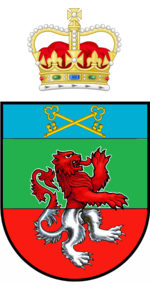Sovereign of the Decracy of Vilthia
Sovrano dello Stato della Decrazia di Vilthia | |

| |
| Seal of the Regency Office and thus Seal of the Sovereign of the Decracy of Vilthia | |
| Formation | July 10, 2007 (Official) December, 1125 (Traditional) |
| Term length | Life |
| Residence | Central Protectorate Palace |
| Appointed by | College of the Noble Families |
| Actual sovereign | Titianus II |
The Sovereign of the Decracy of Vilthia, also known as King (de factothis title is no longer used since 2013) is the head of state and of government of Vilthia and, as such, is Regent of the Central Protectorate.
The Sovereign has the executive, legislative and judicial powers, that, in his name, are transferred to and exercised by other officers. Justice emanates from the sovereign, and is administered in his name, by the judges that he establishes. The executive power, instead, is delegated by the sovereign to the Governatorate of the Central Protectorate. Legislative power is vested in the Sovereign and all the Nobles who meet in the Council of Nobles, that is chaired by the Sovereign.
The office of the Sovereign is the Regency Office, the highest office of the Central Protectorate.
His full titles are: Sovereign of the Decracy of Vilthia, Regent of the Central Protectorate, Protector of the Homeland, Lord of Vignetia, Grand Master of the Brotherhood of Saint Sebastian, Commander in Chief of the Vilthian Armed Forces.
This office was created inspired by that of the Doge of Venice.
History
Saint Sebastian Brotherhood
During the most recent period of life of this brotherhood from which the current "Vilthia" derives, the members gathered in a conclave to elect two regent captains.
They were generally two members of the main and most important families.
Regent Captains became real references to the community, as the political situation of the Italian state at the time did not guarantee the local communities the necessary help and assistance.
Election
Currently the constitution provides that the Sovereign is elected according to the laws laid down by the Central Protectorate. The traditional method of election, inherited from the Brotherhood of San Sebastiano, is the Conclave.
The Conclave is a meeting oh the heads of Vilthia's noble families (College of the Noble Families), who meet at the Central Protectorate to elect, amongst the members of the 5 Great Houses (owners of the lands forming Vilthia), the new Sovereign.
The oldest laws also allow the election by acclamation: it may take place if at least 50% of the population of each province or feud meets in the provincial or feudal capital, and unanimously appeals to a name. If in all 5 territories the same name is acclaimed, that person will be the new Sovereign.
In the election by acclamation any citizen is eligible, while in Conclave only the heads of the 5 Great Houses.
However, the law sets the limits for this type of election, which in fact only took place once in 1947: the election can not take place if the Conclave has begun, there must be no sign of co-ordination between the various provinces or feuds and the candidate must be acclaimed in unison.
Powers
As absolute monarch of Vilthia, the Sovereign (on very rare occasions also called King) holds the executive, legislative and judicial powers with the only limits imposed by the constitution. The Council of Nobles can be considered a supervisor of the activities of the Sovereign, as it has the power to remove him from his office.
The procedure for the removal of a Sovereign is very complex and has never been implemented.
Article 67 of the constitution establishes that the Council of Nobles, with at least 4 out of 5 votes, may indict the Sovereign in case of obvious violations of the Constitution or in case of treason.
Subsequently, the complaint of the Council must be examined by the "Tribunale della Suprema Provvidenza", which will have the last word on the removal of the Sovereign.
Royal Symbols
The law defines which are the official symbols of the Sovereign:
- The Seal of the Regency Office;
- The Personal Seal;
- The Royal Ring;
- The Royal Standard.
|
The Regency Office is represented by a Seal, which is rarely used, and usually represents the office of "head of state" of Vilthia.
The Vilthian traditions require that each Sovereign should be equipped with a personal seal, designed according to pre-established parameters (although the Sovereign is free to personalize the salient features).
The Personal Seal is used on all official documents and, in fact, during the regency of a Sovereign it automatically becomes the symbol of the Office itself, while the Regency Office seal is used on the front of all decrees and all laws and in a small group of documents, it is also used as "Personal Seal" when the Sovereign has not yet chosen his Seal.
The Personal Seal accompanies, together with the signature, every act issued by the Sovereign and it is necessary to prove its authenticity.
Otherwise, the monogram has no legal value and is not provided for by any official legislation, although every sovereign has its own.
Another Symbol of the Sovereign's power is the Royal Ring.
A gold ring is made for each Sovereign, and the Sovereign can choose whether to represent his initials or his personal seal on it. Since 2007, all the Sovereigns have chosen to represent their monogram on it.
The law establishes that the ring can be used by the Sovereign to authenticate the documents, decrees or requests issued by him (for this reason the ring is destroyed on his death), however this practice has become obsolete, and today the ring has a purely symbolic function.
The law also provides, as a symbol of the sovereign, the Royal Standard: it consists of the first flag adopted by the nation, a green vexillum with the letter Y stamped on it together with the crossed keys.
Today the Standard is rarely used, as the sovereigns prefer to expose the banners of the family of origin.
The only place where it is still used are the official residences of the Sovereign, where the Banner is displayed if the Sovereign is present.
Royal styles
Reference style: His Royal Excellency | Sua Eccellenza Reale
Spoken style: Your Grace | Vostra Grazia
Alternative spoken style: Excellency | Eccellenza
Residence
The official residence and working place of the Sovereign is the Central Protectorate Palace in Vignetia.
The Sovereign also has at his disposal as royal residences:
- Saint Michael Cottage in the Province of Teratiliventhia, used as country and summer retreat and also used to host meetings or guests;
- Villa Rosa in the Province of Colat;
- Palace of Travai in the Province of Pozut
List of sovereigns
- Titianus I (born Ludovico Della Vedova), 10 July 2007 - 1 December 2010 (abdicated due to internal conflicts of 2009)
- Claudius I (born Claudio Zannier), 10 December 2010 - 1 May 2013 (abdicated due to personal problems)
- Titianus II (born Federico Marcuzzi Zappi), 12 May 2013 - ...




